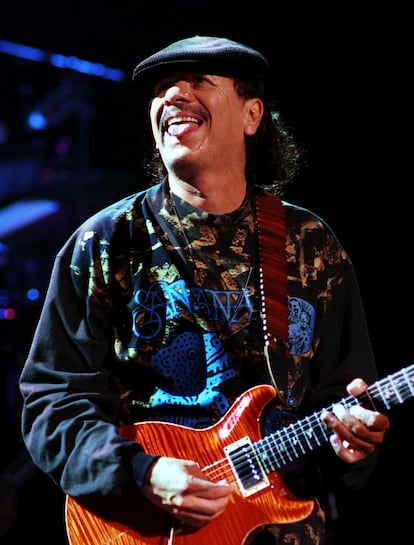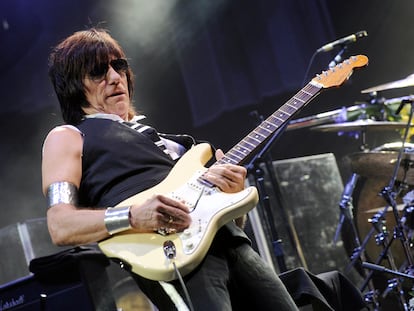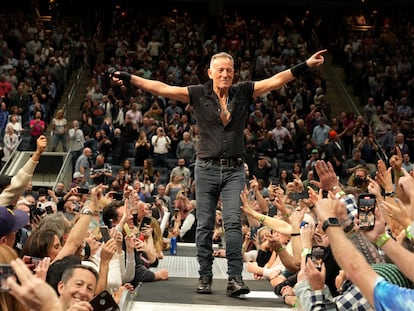Documentary ‘Carlos’ is a loving, respectful portrait of guitar god Santana
The movie is a traditional linear tale, tracing Santana’s formative years in Tijuana, Mexico, his set at Woodstock, his relentless touring and dive into spirituality, climaxing with his triumphant 1999 ‘Supernatural’ album

A new documentary on rock icon Carlos Santana begins with the legendary philosopher-guitarist asking a simple question: “Do you believe in magic?”
“Magic. Not tricks — the flow of grace,” he says.
You may be convinced you do a little less than 90 minutes later by director Rudy Valdez’s intimate portrait of a man with a magical ability and a story told with few tricks.
Carlos is a traditional linear tale, tracing Santana’s formative years in Tijuana, Mexico, his set at Woodstock, his relentless touring and dive into spirituality, climaxing with his triumphant 1999 “Supernatural” album.
It’s lovingly told — and intimate. There is the first known recording of a 19-year-old Santana in 1966 — already a guitar master with a familiar, blistering style — and one later in life in which he delights his children behind a couch with sock puppets.
But some of the most powerful images are several old homemade clips Santana made himself, alone at home just jamming. It’s like hearing the magic flow straight from the source, watching unfiltered genius work while his guitar gently wails.
Valdez uses various images almost like a collage to capture his subject — talk show clips, old concerts, and newly conducted interviews with the master, one at sundown with the icon beside a fire. The only forced bit is a roundtable of Santana’s wife and sisters.
A highlight is watching Santana and his band play in the rain during 1982′s Concert for the Americas in the Dominican Republic. Other directors might show a short clip and go but Valdez lets it play long, a treat.
We see Santana grow up to a violinist father and a fierce mother, who became mesmerized by the blues-rock of Ray Charles, B.B. King and Little Richard. He was pressing tortillas at a diner in San Francisco in the late 1960s — he calls the city a “vortex of newness” — and go to the Fillmore to listen to the Grateful Dead and Country Joe and the Fish.
After being busted trying to sneak into the legendary venue without paying, impresario Bill Graham was so impressed by this skinny guitarist that he invited him to open for the Who, Steve Miller and Howling Wolf.
At Woodstock — he and his band wouldn’t have their debut album out for months more — Santana hits the stage very high by accident (Thanks, Jerry Garcia) and says a little prayer: “God, I know you’re here. Please keep me in time and in tune.” Throughout his set, Santana seems to be wrestling the neck of his guitar, which to him resembled a snake.
His first royalty check was spent on a home and a refrigerator for mom, fulfilling a promise. “It’s better than Grammys and Oscars and Heisman trophies. It feels better than anything,” he says in the documentary.
Inevitably, the fall comes, with the drugs and overindulgence. Shocked by the deaths of Jimi Hendrix and Janis Joplin, Santana decides he must choose between heroin or spiritual meditation. He picks the latter, dresses in white, eats healthy, turn to jazz and decides to “surf the cosmos of imagination.”
With enduring hits like Oye Como Va and Black Magic Woman, Santana was voted into the Rock & Roll Hall of Fame in 1998, the first person of Hispanic heritage to be inducted. But he wasn’t done yet. “This Earth time is an illusion,” he argues, after all.
Supernatural, which arrived in 1999 during a Latin pop explosion, won a total of nine Grammys with such hits as Smooth, Put Your Lights On and Maria Maria. He is called a second-act king. Man, he’s a hot one.
Valdez shows real style illustrating that Santana’s bands were far from stable when it came to its lineups — he cleverly shows various different singers belt out the same section of Black Magic Woman live — and captures Santana today watching an old concert he did with his late dad. “He’s proud of me and I’m proud of him. And I miss him,” he tells the camera.
Santana deserves to be on the Mount Rushmore of rock and that’s why in so many ways Carlos is a corrective to the thinking of people like Jann Wenner, co-founder of Rolling Stone, who overlooked Santana for his new book of transcendent rockers, The Masters. A master is hiding in plain sight.
Sign up for our weekly newsletter to get more English-language news coverage from EL PAÍS USA Edition
Tu suscripción se está usando en otro dispositivo
¿Quieres añadir otro usuario a tu suscripción?
Si continúas leyendo en este dispositivo, no se podrá leer en el otro.
FlechaTu suscripción se está usando en otro dispositivo y solo puedes acceder a EL PAÍS desde un dispositivo a la vez.
Si quieres compartir tu cuenta, cambia tu suscripción a la modalidad Premium, así podrás añadir otro usuario. Cada uno accederá con su propia cuenta de email, lo que os permitirá personalizar vuestra experiencia en EL PAÍS.
¿Tienes una suscripción de empresa? Accede aquí para contratar más cuentas.
En el caso de no saber quién está usando tu cuenta, te recomendamos cambiar tu contraseña aquí.
Si decides continuar compartiendo tu cuenta, este mensaje se mostrará en tu dispositivo y en el de la otra persona que está usando tu cuenta de forma indefinida, afectando a tu experiencia de lectura. Puedes consultar aquí los términos y condiciones de la suscripción digital.
More information
Archived In
Últimas noticias
The new victims of the Republican war on Obamacare: Millions hit by soaring health insurance premiums
A country divided on migrant rights: Some US states expand protections while others restrict them
Venezuela authorizes the release of another 87 political prisoners
There is as much life left to discover on planet Earth as that which is already known
Most viewed
- David King, chemist: ‘There are scientists studying how to cool the planet; nobody should stop these experiments from happening’
- Reinhard Genzel, Nobel laureate in physics: ‘One-minute videos will never give you the truth’
- Oona Chaplin: ‘I told James Cameron that I was living in a treehouse and starting a permaculture project with a friend’
- Sinaloa Cartel war is taking its toll on Los Chapitos
- The Interoceanic Train, the Mexican alternative to the Panama Canal










































